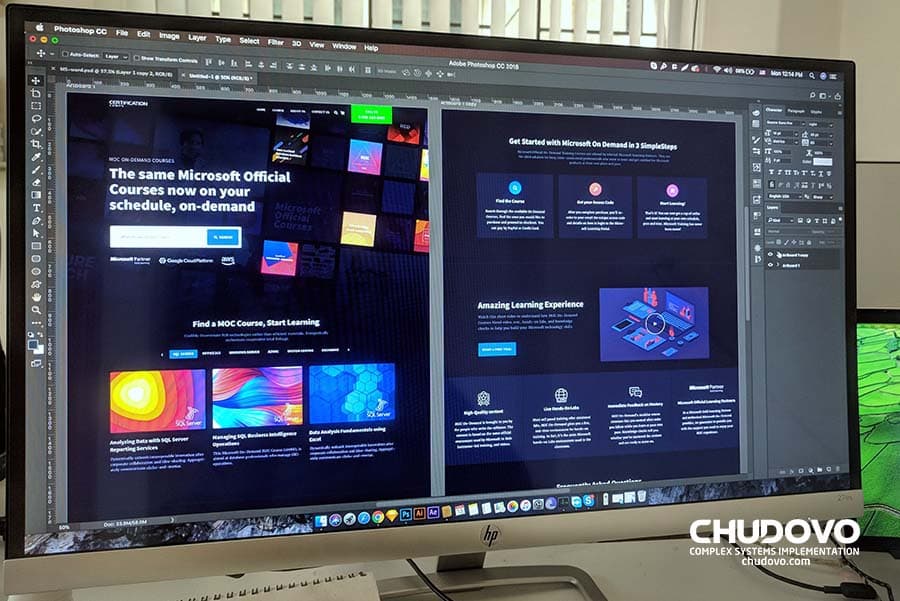Step-by-Step Guide to Web Design Outsourcing
Today, the ever-expanding landscape of the web is important for any business, and many are outsourcing web design services. The evolution of web design in 2023 brings forth an array of dynamic websites, cloud platforms, and mobile apps. Given the pros of outsourcing – from cost savings to tapping into diverse expertise – it’s no wonder many are opting for this route.
But where does one begin to outsource website design or mobile app development? Is outsourcing web development the same as outsourcing web design? What does the process cost, and how do teams collaborate seamlessly in this model? These are some of the most commonly asked questions in web design outsourcing. Let’s dig deeper and find answers to all these questions – from frontend development intricacies to the nuances of design work for both web and mobile platforms.
Table of Content
- The Emergence of Web Design Outsourcing
- Understanding Web Design Outsourcing
- Pros and Cons of Web Design Outsourcing
- Choosing the Right Outsourcing Partner
- The Outsourcing Process: A Step-by-Step Breakdown
- Post-Project Management
- Best Practices in Web Design Outsourcing
- Conclusion
- Frequently Asked Questions

The Emergence of Web Design Outsourcing
The demand for top-notch web design has skyrocketed, and the trend to outsource web design has emerged. Many businesses banked on in-house teams to manage their web and mobile app design needs.
However, the challenges began to mount as the digital landscape expanded with advancements in cloud and intricate frontend development. The cost and resources to consistently produce innovative design work became frequent hurdles. This is where outsourcing web design came into play.
Choosing to outsource website design gave businesses a dual benefit: substantially reducing overhead costs and access to a global talent pool. This allowed firms to engage with expert outsourced web designers worldwide. These teams brought a treasure trove of tips and insights, enriching the web design process.
Understanding Web Design Outsourcing
Web design outsourcing involves contracting an external team or individual to handle your web design work. Instead of relying on an in-house team for every design project, businesses and individuals can outsource web design services to specialized professionals or agencies for a full-blown website, mobile app, or specific front-end development tasks. This allows flexibility, cost-efficiency, and access to a broader range of expertise.
Over the past years, notably in 2023, the digital arena has experienced rapid changes. With the proliferation of mobile devices, cloud platforms, and intricate web functionalities, the demand for specialized design skills has soared.
As a result, the model of outsourcing web design has evolved by leaps and bounds, accommodating these growing and diverse needs. In the early days, one might outsource website design for a simple static page. Now, the scope includes everything from complex web development to intricate mobile app interfaces, making outsourcing web development a more prevalent choice.
Key Factors Driving the Trend
Key Factors Driving the Trend Several factors propel the move towards web design outsourcing:
- Cost Efficiency: Maintaining an in-house team can be expensive. When outsourcing web designer expertise, you often save on overhead costs and pay only for the specific design work you need.
- Expertise Access: Outsourcing enables businesses to tap into a global talent pool. Whether you need niche front-end development skills or general web design work, there’s likely an expert who specializes in just that.
- Flexibility: The digital world is dynamic. By outsourcing website design, companies can scale their design efforts up or down based on project demands without the long-term commitments tied to hiring full-time staff.
- Time-saving Tips and Insights: Outsourced web designers often bring a wealth of experience from various projects. They can provide invaluable tips, insights, and best practices to streamline the process and enhance the final product.

Pros and Cons of Web Design Outsourcing
Web design outsourcing has emerged as a prominent strategy for businesses seeking a solid online presence. The advantages of outsourcing are numerous. Primarily, companies find it cost-effective, avoiding the overheads associated with hiring and maintaining an in-house team.
Businesses can tap into a global reservoir of expertise by opting to outsource web design, ensuring they receive top-notch front-end development for their websites and mobile apps. The flexibility inherent in outsourcing allows for easy scalability of projects, adapting to fluctuating requirements without long-term commitments.
Additionally, due to the varied time zones of global teams, there’s potential for round-the-clock work, expediting project completion, and bringing products to market faster. Furthermore, external designers often infuse fresh and innovative perspectives into the design work, armed with diverse experiences and unique tips.
Potential Challenges and Drawbacks
While the pros of outsourcing web design are enticing, there are challenges to consider. Communication barriers, stemming from time zone differences or language nuances, can hinder smooth project flow. Some businesses might feel a loss of control when tasks are outsourced, leading to concerns about the project’s trajectory.
Quality consistency is another concern; without stringent guidelines and proper vetting, there can be variability in the output. Data security, especially in today’s interconnected cloud-based world, is paramount, and outsourcing poses potential risks if not managed correctly. Lastly, while outsourcing is often lauded for cost-efficiency, unexpected changes or revisions can introduce unforeseen expenses.
Mitigating Common Outsourcing Risks
A few strategies are paramount to successfully navigating the web design outsourcing world and mitigating these risks. Establishing clear communication channels, employing collaboration tools, and having regular check-ins can bridge the communication gap. Ensuring comprehensive contracts with outsourced web design services is essential, addressing aspects like quality expectations, revisions, costs, and intellectual property rights.
Thorough vetting, supported by reviews and references, can provide insights into the reliability and expertise of potential partners. Emphasizing data protection protocols is non-negotiable to ensure sensitive information remains secure. Lastly, having a well-defined project scope, with clear deliverables and milestones, not only ensures alignment with the outsourcing partner but also aids in effective progress tracking and budget management.

Choosing the Right Outsourcing Partner
One of the most crucial decisions in outsourcing is selecting the right partner. This choice will shape your web design work’s quality, efficiency, and overall success. Finding a partner who understands your vision and goals is paramount. Beyond technical know-how, a genuine interest in your project’s success often translates to better outcomes. A partner’s reliability, commitment to timelines, transparency in communication, and adaptability to feedback should also be gauged. With the numerous options available for outsourcing web design services, it’s essential to sift through and identify those that resonate most with your values and expectations.
- Technical Expertise: In the realm of web design and front-end development, technological prowess is non-negotiable. As the digital landscape evolves, especially in design 2023, your outsourcing partner must be adept with the latest tools, platforms, and design philosophies. Whether creating an interactive website, designing a mobile app, or integrating cloud functionalities, the depth of technical expertise can significantly impact the final product.
- Industry Experience: While generic web design skills are valuable, specific industry experience can provide an added edge. A partner familiar with your business sector can offer invaluable insights into understanding the unique challenges and nuances your project might entail. For instance, designing for an e-commerce platform requires a different approach compared to a nonprofit organization’s site. This familiarity can streamline the process, ensuring a design that resonates with your target audience.
- Cultural Fit: Often overlooked, cultural fit plays a pivotal role in the success of outsourcing web design. It’s not just about language or time zones but about shared values, work ethics, and communication styles. A harmonious partnership can simplify feedback loops, reduce misunderstandings, and foster a collaborative environment where both parties feel valued and understood.
Red Flags to Stay Clear Of
When navigating the intricate world of web design outsourcing, it’s not just about identifying the right partners but also about being wary of potential pitfalls. Certain red flags can serve as early warnings, helping businesses avoid unsuitable or problematic outsourcing partners.
- Unrealistic Promises: Some firms might be tempted to over-promise to secure clients in the competitive arena of outsourcing web design services. While it’s constantly enticing to hear about quick turnarounds, ultra-low costs, or guarantees of unmatched quality, such unrealistic promises can be misleading. Remember that quality web design work, especially in the nuanced design landscape of 2023, requires time, effort, and expertise. When a web designer or firm pledges something that sounds too good to be true, it often is. Instead of getting swayed by grand promises, businesses should rely on proven track records, tangible deliverables, and transparent processes.
- Ambiguous Communication: Effective communication is the backbone of any successful outsourcing endeavor. If an outsourced website design firm or individual needs to be more specific in their responses, hesitant to provide clear timelines, or consistent in their updates, these are immediate red flags. Ambiguity can lead to misunderstandings, affecting the web design project’s outcome and causing delays and potential cost overruns. Moreover, in an industry where tips, feedback, and iterative processes play pivotal roles, ambiguous communication can hinder the collaborative spirit essential for outstanding front-end development.

The Outsourcing Process: A Step-by-Step Breakdown
The diverse platforms, varied design aesthetics, and many talented professionals available can create a paradox of choice. Yet, the haze surrounding the outsourcing world dissipates by systematically dissecting each stage of the process. This step-by-step approach simplifies the entire endeavor and paves the way for a streamlined, well-informed, and rewarding journey in crafting a digital presence.
Defining Your Project Requirements
The foundation of successful outsourcing begins with a clear vision. Before even outsourcing web design, it’s essential to define your project requirements thoroughly. This involves understanding the nuances of your design, the platforms it will span (website, mobile app, or cloud integrations), the expected cost parameters, and the desired timelines. A detailed brief guides the entire project and helps potential designers or agencies understand your vision.
Researching Potential Designers/Agencies
Once you grasp what’s needed, the next step is to dive into research. In the vast digital ocean of design 2023, numerous outsourced web designer professionals and agencies offer various web design services. Looking into portfolios, reading reviews, and understanding their areas of expertise can help shortlist potential candidates that align with your project’s demands.
Initiating Contact and Vetting
After shortlisting, the next phase is reaching out. This step is crucial, as initial conversations can provide a glimpse into the designer or agency’s communication style, commitment, and professionalism. It’s also the stage to vet their technical capabilities, ensuring they can handle the specific front-end development needs or other design complexities your project might entail.
Negotiating the Contract
Once a potential partner is identified, the focus shifts to the nitty-gritty of the contract. This document should comprehensively cover deliverables, timelines, costs, revisions, and intellectual property rights. A transparent contract provides legal protection and sets clear expectations for both parties, reducing potential friction points.
Embarking on the Design Journey
With the contract in place, the actual design work begins. This phase involves iterative processes, regular check-ins, feedback loops, and potential tweaks based on evolving requirements. Open communication, collaboration tools, and regular updates are essential to ensure the web design work aligns with the initial vision and requirements.
Finalizing and Handing Over the Project
Upon reaching the project’s conclusion, there’s a process of final reviews, testing, and handovers. This ensures that the design is visually appealing and functional across platforms. Once everything is in order, the project assets, source files, and other deliverables are handed over, marking the project’s successful completion.

Post-Project Management
Post-project management is a pivotal component often overlooked in the vast landscape of web design outsourcing. While many might perceive the conclusion of a design project as the final step, it’s merely a transition into an equally crucial phase. Once the design goes live, the real test of its efficacy and relevance begins. As digital trends shift and business objectives evolve, the design must adapt to stay aligned.
This adaptive process, known as post-project management, is essential for maintaining the design’s functionality, ensuring it continues to resonate with its target audience. It’s not just about creating a visually appealing platform; it’s about ensuring it remains responsive, user-friendly, and in tune with the brand’s ongoing narrative and the ever-changing digital ecosystem.
Nurturing the Relationship
After successfully collaborating to outsource web design, nurturing the relationship with the designer or agency is vital. A positive, ongoing relationship paves the way for future collaborations, making subsequent projects smoother due to the established rapport. Regular check-ins, feedback sessions, and even simple gestures like sending appreciation notes can go a long way in fostering goodwill. It’s not just about the immediate design work but about building a lasting partnership that understands and grows with your brand’s digital journey.
Ensuring Continuous Support and Maintenance
Digital platforms require consistent support and maintenance, be it a website, mobile app, or cloud integration. As technologies evolve and user behaviors change, especially in the dynamic sphere of design 2023, ensuring that the platform functions seamlessly becomes paramount. With a support agreement with the outsourced website design partner, businesses can promptly address bugs, optimize performance, and implement essential updates, ensuring that users always get the best experience.
Revisiting and Updating the Design
The digital landscape is ever-changing. What’s trendy and user-friendly today might become outdated tomorrow. Therefore, periodically revisiting and updating the design is essential. Leveraging the tips and expertise of the original outsourced web designer can be beneficial, as they’re already familiar with the project’s intricacies. Whether tweaking the frontend development to align with new browser updates or refreshing the aesthetics to resonate with contemporary design philosophies, an updated design ensures the platform remains relevant and engaging.

Certified engineers
Convenient rates
Fast start
Profitable conditions
Agreement with
EU company
English and German
speaking engineers
Best Practices in Web Design Outsourcing
Best Practices in Web Design Outsourcing form the cornerstone of a successful digital project. The journey of web design outsourcing goes beyond the initial step of selecting a proficient partner. It encompasses the entire experience, from the commencement of talks to the delivery and even post-project interactions. A harmonious collaboration is essential to transform an abstract vision into a tangible, functional design.
While the skills and expertise of the chosen outsourced web design agency play a pivotal role, the relationship’s dynamics equally influence the project’s outcome. A structured, communicative, and transparent approach can elevate this collaborative experience. By embracing certain best practices, businesses can not only streamline the design process but also ensure that the final digital product reflects the brand’s ethos, resonating deeply with its intended audience and catering to their needs.
Effective Communication Tools and Platforms
In web design outsourcing, communication stands as the linchpin for project success. Leveraging effective communication tools and platforms can bridge the gap between the client and the outsourced web designer. Platforms tailored for cloud collaboration, file sharing, real-time feedback, and video conferencing can simplify the exchange of ideas, ensuring that the design process remains seamless. These tools facilitate the sharing of design work and enable teams to stay on the same page, regardless of geographical distances.
Managing Time Zones and Remote Work
The global nature of web design outsourcing means that your partner might be working from a different part of the world. Managing time zones becomes crucial to ensure that work progresses without hiccups. Both parties can operate efficiently by setting clear expectations regarding work hours, deadlines, and check-ins. It’s also beneficial to have overlapping work hours, allowing for real-time discussions, especially when working on complex aspects like front-end development or mobile app interfaces.
Fostering Trust and Transparency
Building a foundation of trust is paramount in any outsourcing relationship. Being transparent about expectations, costs, potential challenges, and feedback fosters a sense of trust. On the other hand, the outsourced website design agency should be open about its capabilities, potential roadblocks, and progress updates. This two-way transparency alleviates potential misunderstandings and nurtures a collaborative environment. When the client and the design team trust each other, the result is often more aligned with the vision and crafted with mutual respect and understanding.
Conclusion
Web design outsourcing stands out as a strategic choice for many big and small businesses. It offers access to global talent, cost efficiencies, and the flexibility to adapt to changing market needs. However, like any strategic endeavor, its success is rooted in technical proficiency, solid and transparent partnerships, and a commitment to best practices. By embracing clear communication, understanding mutual expectations, and staying updated with industry trends, businesses can harness the full potential of outsourcing.
Frequently Asked Questions
What are the main benefits of web design outsourcing?
Outsourcing web design allows businesses to tap into a global talent pool, ensuring access to top-notch design expertise without the overheads of maintaining an in-house team. It provides cost efficiencies, flexibility in scaling projects, and the ability to get diverse, fresh design perspectives.
How do I ensure effective communication with an outsourced design team?
Effective communication is pivotal when working with an outsourced team. Leveraging collaborative tools, setting regular check-ins, and ensuring some overlapping work hours can facilitate smooth communication. Additionally, clear documentation and feedback mechanisms can further streamline the process.
How do I manage the cost implications of outsourcing my web design?
It’s essential to have a clear contract that outlines deliverables, timelines, and cost structures. This not only helps in budgeting but also in setting expectations. Periodic reviews and transparent discussions about additional costs or changes can keep the project within the desired budget.
Can I update or modify my website/app design once the outsourcing project is complete?
Yes, post-project updates and modifications are common. Discussing post-project support and maintenance terms with the design agency or freelancer is beneficial. Having an agreement ensures that any future changes can be implemented seamlessly, keeping your digital platforms up-to-date.
If you need qualified web developers, contact us now!




